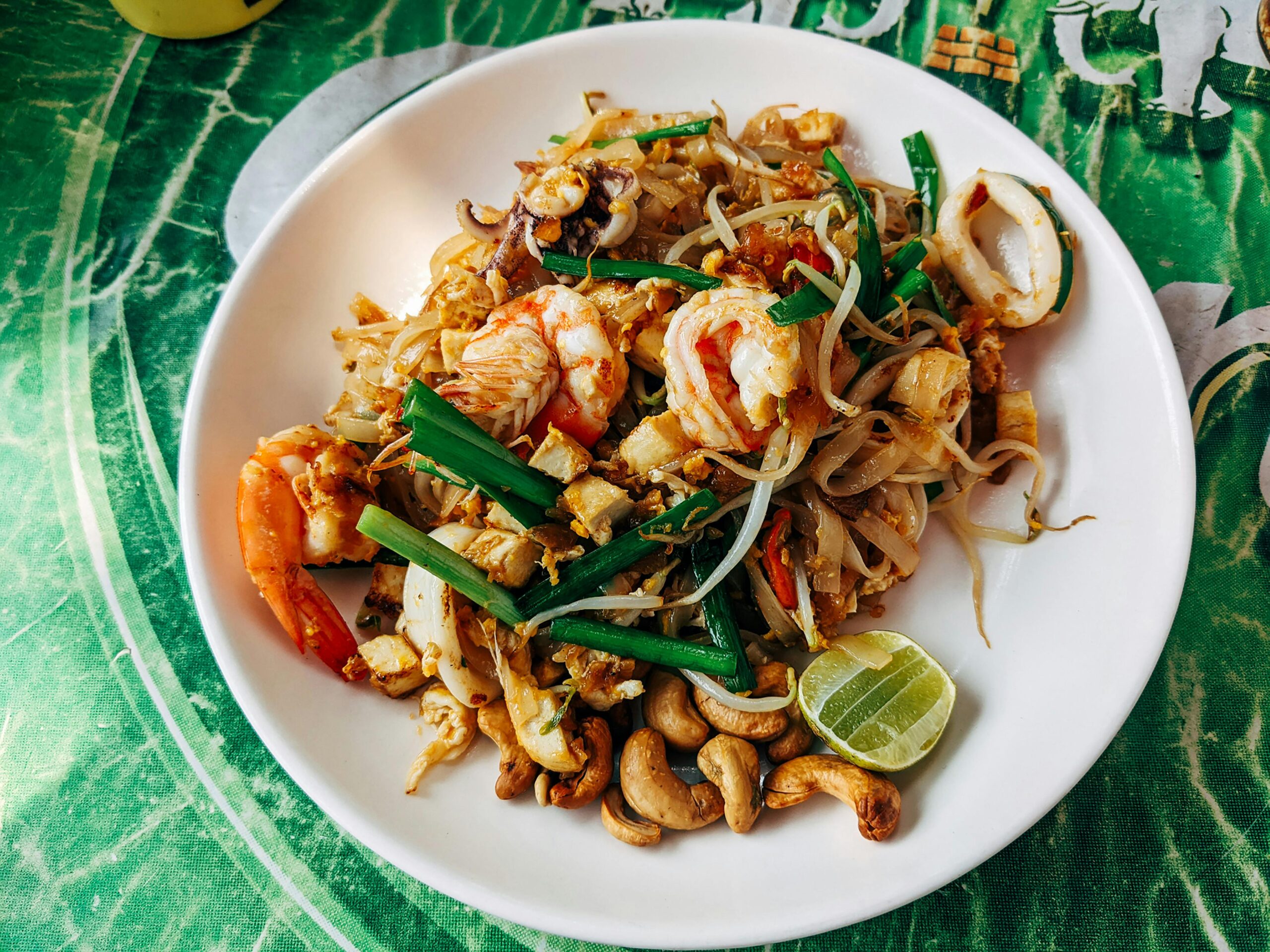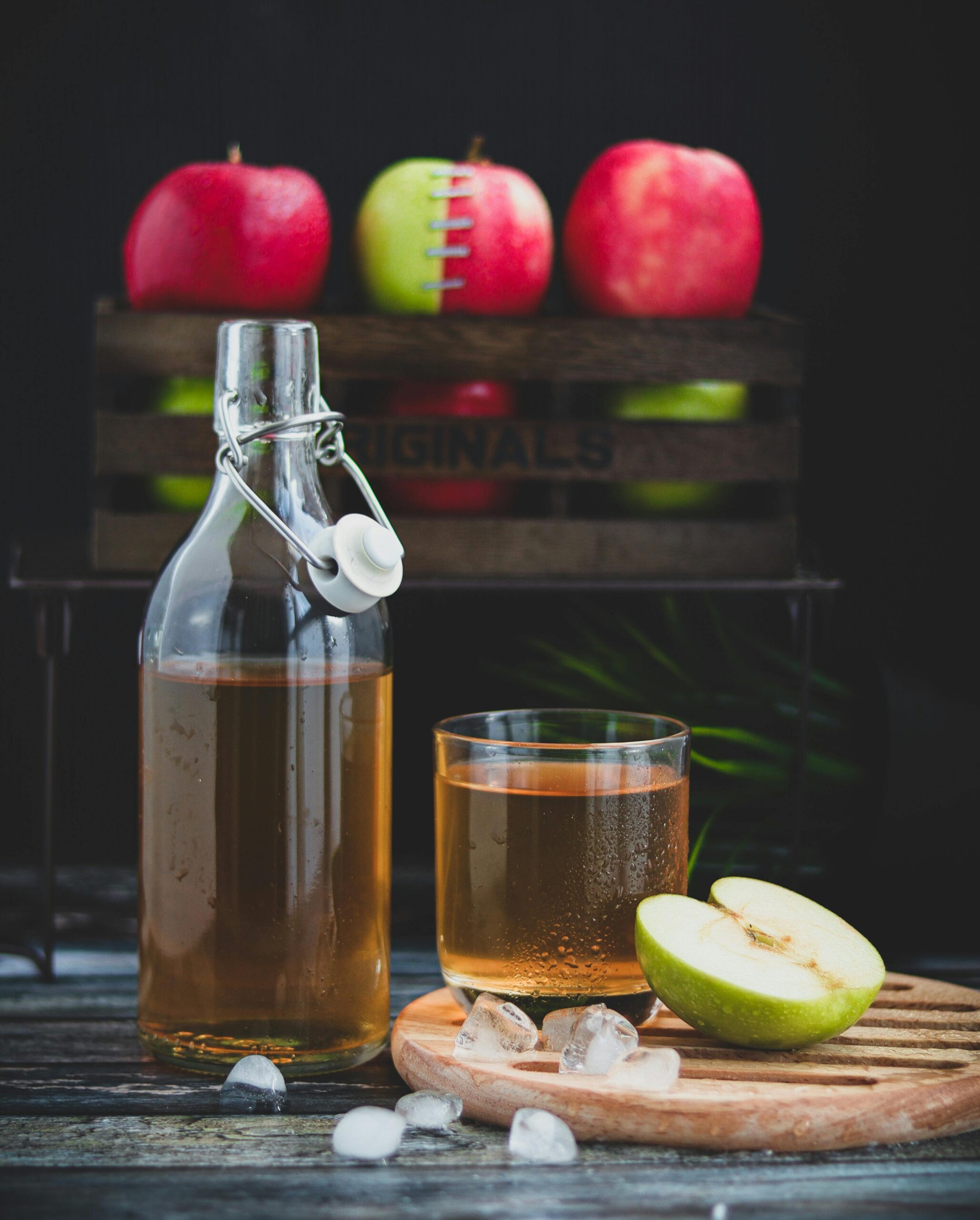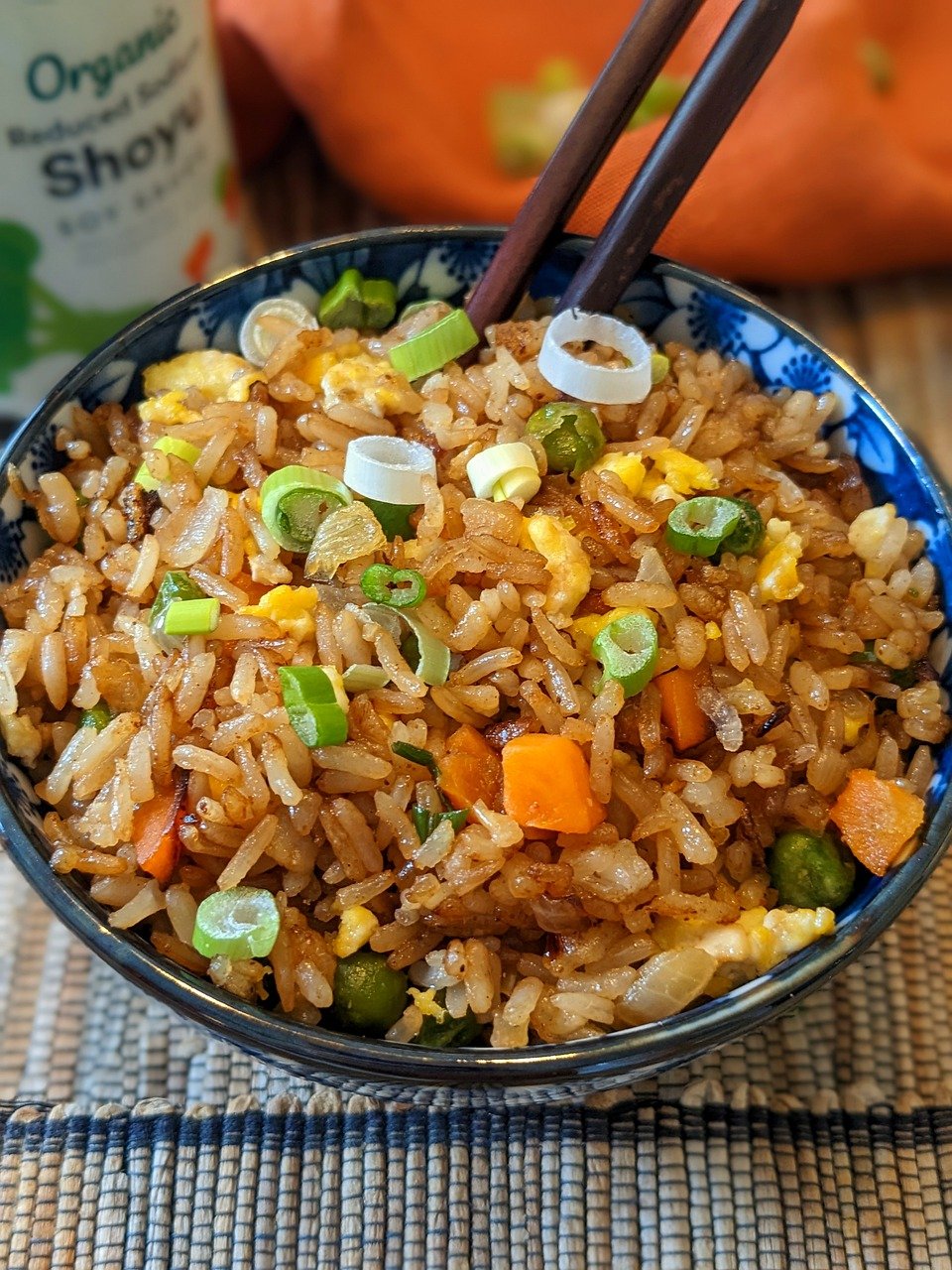Thailand is famous for its vibrant street food culture offering a plethora of delicious and flavorful options. Here are seven popular Thai street foods enjoyed across the country. These delicious street foods reflect the diverse and rich culinary heritage of Thailand and they are a must-try for anyone visiting the country.
First, we have Pad Thai, a famous stir-fried noodle dish that is a staple of Thai cuisine. It typically includes rice noodles, eggs, tofu, shrimp, bean sprouts, and crushed peanuts, all seasoned with tamarind juice, fish sauce, and red chili pepper. The combination of sweet, sour, and spicy flavors makes Pad Thai a favorite among locals and tourists alike.
Next, a street food favorite is Tom Yum Goong, a hot and sour soup that is packed with fragrant herbs, lemongrass, galangal, kaffir lime leaves, and fresh prawns. The soup is known for its bold and invigorating flavors, making it a popular choice for those seeking a spicy and aromatic culinary experience.
Then there’s Khao Niew Ma Muang or Mango Sticky Rice, this popular Thai dessert can also be found as a street food. It features ripe mango slices served with sweet glutinous rice drizzled with coconut milk. It’s a delightful combination of flavors and textures.
Kai Jeow, or Thai Omelette is a simple yet flavorful Thai omelette. Beaten eggs minced with fish sauce, soy sauce, and something minced meat or vegetable make up this dish typically, it accompanies steamed rice and a side of spicy dipping sauce.
Satay is a favorite street food in Thailand. Chefs serve skewers of marinated and grilled meat, typically chicken or pork, with a peanut dipping sauce. They often season the meat with spices like turmeric and lemongrass, resulting in a fragrant and tender dish.
Thai iced coffee, known as “Oliang” or “Thai Iced Coffee,” is a popular and refreshing beverage in Thailand It’s characterized by its strong, sweet, and creamy flavor, often enjoyed over ice. Here’s a detailed look at this beloved drink.
Last but not least, we have Fried Thai basil with minced pork and Rice, known as pad Krapow Moo Sap in Thai, which is a popular and flavorful dish in Thai cuisine. It’s made by stir-frying minced pork with garlic, chili, and holy basil leaves in a savory sauce. So let’s start to make these delicious recipes.
1. Pad Thai
First, Pad Thai is one of Thailand’s most iconic street foods. it consists of sweet, savory, and tangy flavors. It typically includes stir-fried rice noodles, eggs, shrimp or chicken, tofu, and a variety of vegetables all seasoned with a flavorful sauce.
Pad Thai, a popular Thai dish, offers several benefits that contribute to its appeal and nutritional value:
Rich in Protein: Depending on the recipe, Pad Thai can be rich in protein, especially when prepared with shrimp, and tofu, or chicken. Furthermore, Protein is essential for muscle repair and growth, as well as overall body function.
Balanced Macronutrients: Pad Thai typically includes a good balance of carbohydrates from rice noodles, protein from ingredients like shrimp, tofu, or chicken, and healthy fats from peanuts and oil. This balance helps provide sustained energy and satiety.
Healthy Fats: Peanuts and vegetable oils used in Pad Thai provide healthy fats, including monounsaturated and polyunsaturated fats. These fats are beneficial for heart health, reducing inflammation, and supporting brain function.
Overall, Pad Thai can be a nutritious and delicious addition to a balanced diet when prepared with fresh ingredients and in moderation.
Disadvantages
While Pad Thai is a delicious and popular dish, there are a few potential disadvantages like caloric content; Pad Thai can be high in calories, especially if it’s prepared with a lot of oil. Sodium content; Dish often contains fish sauce or soy sauce, which can be high in sodium. consuming too much sodium can contribute to high blood pressure. so don’t use too much oil and sodium.
Despite these potential disadvantages, Pad Thai can still be enjoyed as part of a balanced diet when prepared with moderation and attention to ingredient choices. Therefore, here’s a basic recipe to make Pad Thai at home!
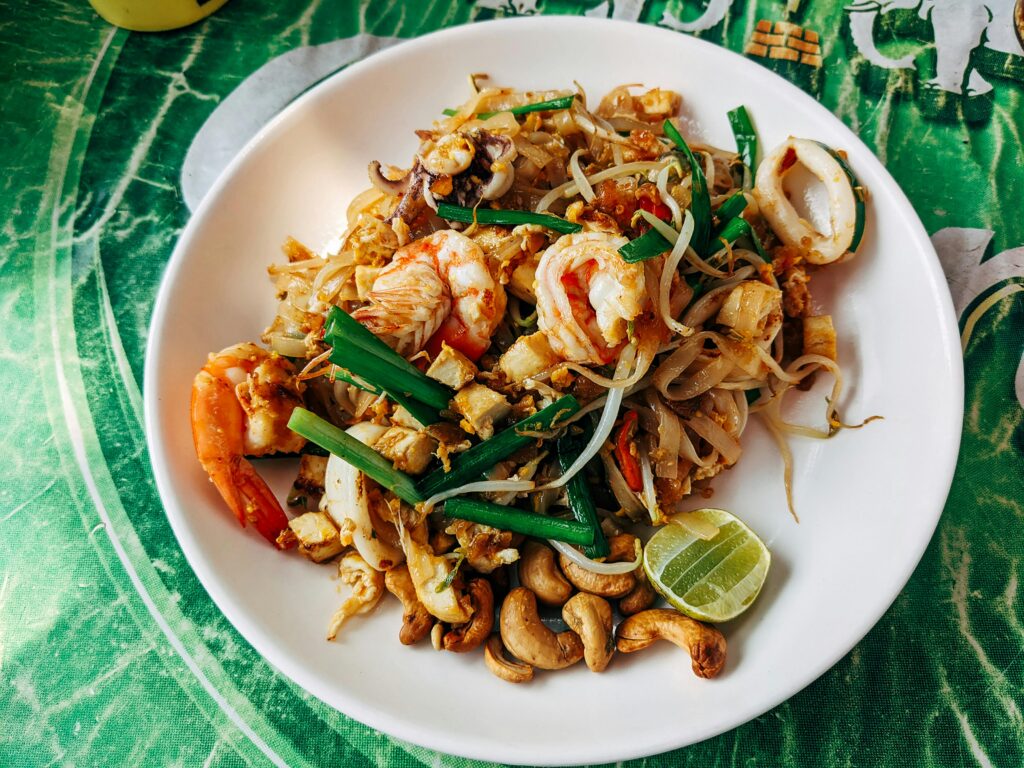
Flavorful: The fresh vegetables and homemade pad thai sauce
Easy: A few simple steps and everything gets tossed together in the same pan!
INGREDIENTS:
- 200g rice noodles
- 2 tbsp vegetable oil
- 2 cloves minced garlic
- 1 small thinly sliced onion
- 2 eggs, lightly beaten
- 200g firm cubed tofu
- 100g peeled and deveined shrimp (optional)
- 2 tbsp tamarind paste
- 3 tbsp fish sauce
- 2 tbsp sugar
- 1/2 cup bean sprouts
- 4 green chopped onions
- 1/4 cup chopped peanuts
- Lime wedges for serving
- Cilantro for garnish (optional)
How To Make Pad Thai:
- Prepare the Noodles: Soak the rice noodles in warm water for about 15-25 minutes until they are pliable but still firm. Drain noodles and set aside or follow package instructions to cook noodles just until tender. rinse under cold water.
- Make the Pad Thai Sauce: In a small bowl, mix together the tamarind paste, palm sugar, fish sauce, soy sauce, rice vinegar (or tamarind paste), and chili flakes until the sugar dissolves. adjust sweetness and tanginess to your taste. set aside.
- Cooking the ingredients: Heat 1 tablespoon of oil in a large pan or wok over medium-high heat. add shrimp( or tofu/chicken) and stir-fry until shrimp turns pink and cooked through ( or tofu/ chicken is lightly Browned). Remove and set aside.
- Stir-fry Eggs: In the same pan, add another tablespoon of oil. crack eggs into the pan and scramble until they are fully cooked. Push the eggs to one side of the pan.
- Combine everything: Now, add the soaked rice noodles to the pan along with the Pad Thai sauce. Use tongs to gently toss and combine everything, ensuring the noodles are evenly coated with sauce.
- Add Vegetables: Add bean sprouts, sliced spring onion, peanuts, and tofu( if using), and stir-fry for another 2-3 minutes until the noodles are tender and all ingredients are heated through.
- Serve: lastly, transfer the Pad Thai to serving plates. Top with crushed peanuts and garnish with lime wages and chopped cilantro( if using). Serve hot Pad Thai.
Tips:
- Adjust the level of spicyness by adding more or less Chilli flakes or serving with extra chili sauce.
- For a vegetarian or vegan version omit the fish sauce and use a soy sauce instead.
- Customise with additional vegetables such as bell papers, carrots, or mushrooms.
- Ensure your pan or wok is hot enough throughout the cooking process to achieve that signature Stir-fry flavor.
Enjoy your Homemade Pad Thai. It’s a versatile dish that you can adjust to suit your taste preferences, making it perfect for a quick and flavorful male at home.
2. Tom Yum
Tom Yum Soup, alternatively known as Tom Yam is one of the most popular soups from the Thai food culture. This dish tantalizes taste Buds with its vibrant flavors and aromatic profile. as a symbol of Thai cuisine’s bold and harmonious blend of spices, herbs, and aromatics. Tom Yum represents the heart and soul of high culinary tradition.
The essence of Tom Yum lies in its hot and sour soup base, renowned for its multi-dimensional and diverse flavors. the name Tom Yum translates to “sour soup” in Thai highlighting its characteristic tanginess, which is achieved through the inclusion of key ingredients such as lime juice, lemongrass, and kaffir lime leaves. These ingredients not only provide the soup with its signature sourness but also infuse it with a refreshing citrusy aroma.
One of the defining features of Tom Yum is its versatility. While the soup typically includes shrimp( Tom Yum Goong) or chicken( Tom Yum Gai), variations abound, catering to diverse dietary preferences and culinary adventures. With its versatility, Tom Yum can cater to diverse palates, offering seafood or Vegetarian options.
In Thai culture, Tom Yum holds a special place as a dish that embodies the spirit of hospitality and conviviality. Whether enjoyed during a rainy day or a special celebration, Tom Yum brings people together and creates a sense of warmth and connection through its culinary experiences.
Tom Yum is more than just a soup; it’s a culinary Masterpiece that celebrates the rich tapestry of Thai flavors and culture. Furthermore, Tom Yum’s captivating flavor, versatility, and health advantages have made it a favorite among food lovers worldwide, providing a delightful and nursing sensory experience.
INGREDIENTS:
- 4 cups of chicken or vegetable broth
- 1 stalk of lemongrass, sliced into 2-inch pieces and bruised
- 3-4 kaffir lime leaves
- 2-3 thin slices of galangal or ginger
- 2-3 thin bird’s eye chillies, smashed
- 200g (7 oz) of protein (shrimp, chicken or tofu)
- 200g (7 oz) of mushrooms (straw mushrooms, button mushrooms, or oyster mushrooms), sliced
- 2 tomatoes, cut into wedges
- 2 tablespoons of fish sauce
- 1 tablespoon lime juice
- 1 tablespoon of sugar
- Handful of cilantro leaves for garnish
INSTRUCTIONS
prepare veggies and herbs:
- Firstly wash 200 grams of Mushrooms very well in water. then slice them, cut the Galangal or Ginger into thin slices, cut the tomatoes into wedges, and chop the cilantro leaves.
- Then rinse the lemongrass stalks and remove the outer fist or two layers. These layers are stiff and hard layers. Discard them or you can add them to your tea or any veg stock that you make.
- Smash the inner steam lightly with a knife and then slice the lemongrass. ( Do note that if you do not have a lemongrass stalk, then you can use 1 long lemongrass leaf. just tie it around itself and then add in soup).
- Take 2-3 Thai Bird’s eye chilies and Smash each one lightly. Now slice the diagonal into large pieces.
bring broth to simmer:
- In a pot, bring that chicken or vegetable broth to a Simmer over medium heat.
Saute veggies, mushrooms, tomatoes
- Heat 2 tablespoons of oil in a pan. Add 2 teaspoon finely chopped garlic. Saute for a minute on low to low medium flame.
- Now, add the veggies, tomatoes, and mushrooms. you can add your choice mix of veggies to the soup. mix well and saute for a minute. Then add three cups water.
Add aromatics:
- Add the lemongrass, kaffir lime leaves, galangal, or Ginger slices, and smashed Thai bird’s eye chilies to the simmering broth. Let it simmer for about 5 minutes to infuse the flavors.
add protein and season:
- Add your choice of protein (shrimp, chicken, or tofu) to the broth and let it cook until the protein is almost done.
- season with salt as per taste and mix well. do and less salt as well we will also be adding soy sauce later.
cook tom yum soup:
- Cover the pan with a lid and simmer on low to medium flame till the veggies are done.
- Do check at intervals when the veggies are being cooked. Cook till the veggies are tender and cooked well.
- Then add sugar ( Palm sugar, jaggery, or coconut sugar). Add 1 teaspoon of soy sauce. Mix very well and simmer Tom Yum soup for a minute.
- Switch off the flame, add 2 tablespoons of lemon juice for a less sour taste.
Serve:
- Add 2-3Tablespoons of coriander leaves( cilantro leaves). stir and check the seasonings. if required you can add more salt, lemon juice, sugar, or soy sauce.
- While serving Tom Yum Soup, remember to remove the lemongrass stalks, red Chilies, kaffir lime leaves and galangal. This cannot be chewed as they are stringy and dense. So do make sure not to finely slice or chop them. Serve Thai Tom Yum Soup hot.
Enjoy your homemade Tom Yum Soup!
3. Mango Sticky Rice
Mango Sticky Rice, a beloved Thai Desert, Encapsulates the perfect balance of sweet and creamy flavors, combined with a hint of saltiness. This delectable dish consists of glutinous rice, fresh mango slices, and a coconut-infused Sauce. creating delightful harmony of textures and tastes that tantalize the palate.
Sticky Rice
At the heart of this culinary delight lies glutinous rice. The cooked grains are semi-opaque and have a gooey sticky texture when cooked. unlike regular rice, glutinous rice has a higher starch content, which gives it its characteristic sticky texture when cooked.
In the traditional method, people soak the rice in water for several hours to soften it before steaming it until tender. This process guarantees that the rice grains achieve the ideal balance between Chewiness and tenderness cooking to perfection.
It is very commonly used in Chinese cooking, such as when making zong Zi ( Sticky rice dumplings), Meatballs coated with sticky rice, pineapple rice, and sticky rice stuffed with lotus root.
Mango
The star of the show is ripe mango and a burst of freshness and sweetness to the dish. Thai variations such as naam dok mai or keo savoy are often favored for their smooth texture and fragrant aroma. The mango is carefully sliced or cubed and arranged on top of the bed of sticky rice, creating a vibrant and visually appealing presentation.
Coconut-infused Sauce
To elevate the flavor profile of the dish, a coconut-infused Sauce is drizzled over the mango and rice. This sauce is made by simmering coconut milk with sugar and salt until it thickens slightly, a sweetness that complements the tartness of the mango perfectly. The addition of salt helps to balance out the sweetness, creating a harmonious blend of flavors that interact with the palate.
The final touch to this culinary masterpiece is a sprinkling of toasted sesame seeds or mung beans, adding a nutty crunch that contrasts with the smoothness of the rice and mango. This garnish not only enhances the texture of the dish but also adds a depth of flavor that completes the sensory experience.
About Mango Sticky Rice
Mango sticky rice is not only a treat for the taste buds but also a feast for the eyes. Its vibrant colors and intricate presentation make it a favorite among food enthusiasts and Instagrammers alike. Whether served in a traditional Thai banana leaf basket or on a modern ceramic plate, mango sticky rice never fails to captivate with its allure and charm.
Beyond its irresistible taste and visual appeal, mango sticky rice holds cultural significance in Thailand. It is often enjoyed during special occasions and festivals, symbolizing abundance, prosperity, and happiness. Its popularity has spread beyond Thailand’s borders, becoming a culinary gem in global cuisine. So, let’s make delicious homemade Mango Sticky Rice!
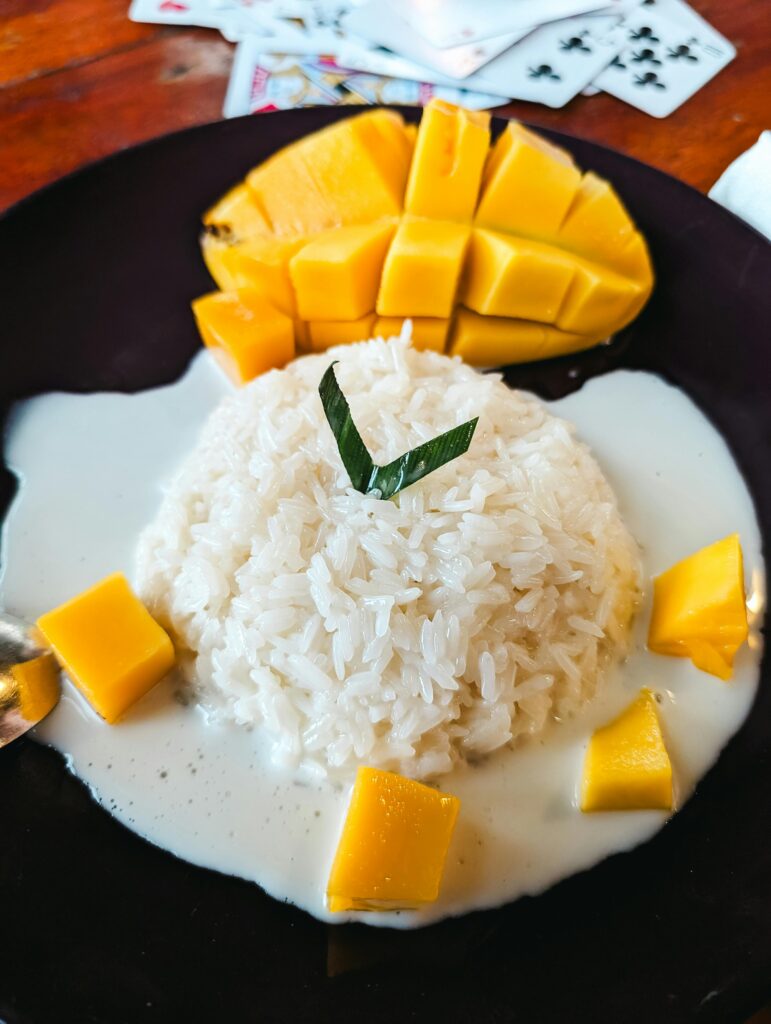
Easy Making
Under 6 Ingredients
You’ll Need:
- 1 cup glutinous rice (also known as sweet rice or sticky rice)
- 1 cup coconut milk
- 1/2 cup granulated sugar
- 1/2 teaspoon salt
- 2 ripe mangoes, peeled and sliced
- Toasted sesame seeds or mung beans (optional, for garnish)
How To Make:
- Soak the rice: Rinse the glutenous rice under cold water until the water runs clear. then, soak the rice in water for at least 4 hours or overnight.
- Steam the rice: Drain the soap raise and place it in a steamer lined With cheesecloth or a clean kitchen towel. Steam the rice over medium heat for about 25-30 minutes, or until it’s standard and cooked through.
- Prepare The Coconut Sauce: In a small saucepan, combine coconut milk, salt to taste, and sugar. Heat the mixture over medium heat, steering vocationally, until the sugar is dissolved. Remove from heat and set aside.
- Mix The Rice And Sauce: Once the rice is cooked, transfer it to a large bowl, then pour about ¾ of the coconut sauce over the rice and gently mix until the right is evenly coated. let it sit for 10 to 50 minutes to allow the rice to observe the sauce.
- Assemble The Dish: To serve, place a portion of the sticky rice on a plate or in a bowl. Arrange the sliced mangoes on top or the side of the rice. drizzles a remaining coconut source over the mangoes and rice.
- Garnish And Serve: Optionally, Sprinkle some toasted sesame seeds or mung beans on the top for extra texture and flavor. now, serve the Mango Sticky Rice warm or at room temperature.
So enjoy your delicious homemade Mango Sticky Rice!
4. Chicken Satay
Satay is a favorite street food in Thailand. Skewers of marinated and grilled meat, chicken, or pork, are served with a peanut dipping sauce. Grilled to perfection for the easy weeknight dinner you can serve over rice or salad and drizzled with homemade peanut sauce.
This recipe is made healthier with less use of sugar. You can also add some veggies onto the skewers for added nutrition and a more filling meal without wasting any time le’s start to make easy and delightful chicken satay!

Perfect summer grilling recipe
Finger licking is good!
INGREDIENTS:
For The Marinade:
- 500g (about 1 pound) boneless, skinless chicken thighs or breast, cut into thin strips
- 2 tablespoons soy sauce
- 2 tablespoons fish sauce
- 1 tablespoon curry powder
- 2 tablespoons brown sugar
- 1 tablespoon lemongrass paste or finely chopped lemongrass (optional)
- 1 tablespoon vegetable oil
for the peanut sauce:
- 1/2 cup creamy peanut butter
- 1/4 cup coconut milk
- 2 tablespoons brown sugar
- 1 tablespoon lime juice
- 1 teaspoon sriracha sauce (optional, for heat)
- Water ( as needed to adjust consistency)
for serving:
- Wooden skewers- Soak them in warm water for 30 minutes to an hour or so to prevent them from sticking to the grill and keep them from getting too brunt during grilling.
- Sliced cucumber, chopped cilantro, and red onion (optional, for garnish)
How To Make:
- Marinate the Chicken: Slice the chicken into the strips. In a small bowl, stir together all the ingredients; soy sauce, fish sauce, brown sugar, turmeric powder, curry powder, minced garlic, lemongrass paste( if using), and vegetable oil.
Add the chicken strips to the marinade. coating them evenly. Cover this bowl and refrigerate for at least 1 hour, or ideally overnight to allow the flavors to meld. - Make the Peanut Sauce: While the chicken is marinating, this is a good time to whip up the delicious Peanut dipping Sauce. In a small saucepan, combine the peanut butter, coconut milk, brown sugar, soy sauce, lime juice, and sriracha sauce (if using).
Heat the mixture over low heat, stirring continuously until smooth and well combined if the sauce is too thick, you can thin it out with a little water. Then remove from heat and set aside. - Thread the Chicken: Preheat your grill or grill pan to medium-high heat. Thread the marinated chicken strips onto the soaked wooden skewers, leaving a little space between each piece. (about 5 pieces per skewer).
Make sure to spray the grill grates with non-stick spray to prevent the chicken satay from sticking. - Grill and Serve: Now, place the chicken skewers on the preheated grill and cook for 3-4 minutes on each side, brushing with the reserved marinade until the chicken is cooked through.
- The internal temperature should read 165 degrees F with a meat thermometer.
- Lastly, arrange the grilled chicken satay on a serving plate, and serve with the peanut sauce on the side for dipping. Garnish with sliced cucumber, red onion, and chopped cilantro if desired for extra freshness and flavor.
Enjoy your homemade Chicken Satay with Peanut Butter Sauce.
5. Thai Iced Tea(Gafae yen)
Gafae Yen or Thai Iced Coffee is a classic Thai drink beloved by Thai people everywhere. This also known as ‘Oliang’ or ‘Oliang Thai’, is a delicious and refreshing beverage that originates from Thailand.
So you better believe we know how to make a good iced drink! Dark, creamy, and sweetened by that magic ingredient it typically consists of strong brewed coffee that is sweetened with mixed sugar, flavored with cardamom, and mixed with evaporated or condensed milk.
Thai coffee sock infuses the coffee with a unique flavor and aroma. After brewing, the coffee is chilled and served over ice, making it a perfect drink for hot days.
This ice coffee is known for its rich, creamy texture and balanced combination of sweetness and slight bitterness, making it a popular choice among coffee enthusiasts worldwide.

Easy making with fewer ingredients. without using sugar.
Yield: Serving 1
You’ll Need:
- 2 cups strong brewed Thai coffee(Preferably using a Thai Coffee Sock for authentic flavor)
- 2-4 tablespoons sweetened condensed milk (adjust to taste)
- 1/2 teaspoon ground cardamom(optional, for extra flavors)
- Iced cubes
INSTRUCTIONS:
- Brew the Coffee: Brew 1 cup of strong Thai coffee with hot water and let it steep for 5 minutes. If you have a Thai coffee sock ( a traditional cloth filter), use it for an authentic flavor or directly in the mixing jug if you will filter it through a dipper later.
- Sweeten and Flavor the Coffee: While the coffee is still hot, stir in 2-3 tablespoons of sweetened condensed milk. Adjust the amount based on how sweet you prefer your coffee.
- Add Cardamom (if desired): If you’d like a hint of spice, sprinkle a pinch of ground cardamom into the coffee and stir well. This is optional but adds a traditional Thai flavor.
- Cool the Coffee: Allow the coffee mixture to cool down to room temperature. You can speed up this process by placing it in the refrigerator.
- Prepare the serving of glasses: When coffee is ready to serve, fill glasses with iced cubes. (you can use tall glasses to make it look more appealing).
- Once the coffee mixture is chilled, pour it over the ice cubes in the serving glasses.
- Enjoy: Stir gently to mix the flavors and enjoy your refreshing Thai Iced Coffee!
Additonal Note: This recipe yields one serving. Adjust the sweetness and flavor according to your taste preferences. Thai Iced Coffee is a delightful treat that combines the richness of coffee with the creaminess of condensed milk and a hint of spice.
Also, Try this Recipes:
6. Thai Omelette(kai jeow)
Kai jeow is a simple yet flavorful Thai omelette. Every Thai eats it, every Thai makes it, and every Thai loves it because it is so easy, affordable, and delicious. Made with eggs, fish sauce, and sometimes soy sauce, it’s quick to prepare and bursting with flavors.
Thai Omelette can be customized with additions like green onions, cilantro, tomatoes, or chilies adding depth to its taste. They are typically served hot with jasmine rice and a side of chili sauce for an extra kick.
Whether enjoyed for breakfast, lunch, or dinner, Thai Omelettes are a staple of Thai cuisine and are appreciated for their satisfying texture and ability to complement other dishes. So let’s make it!
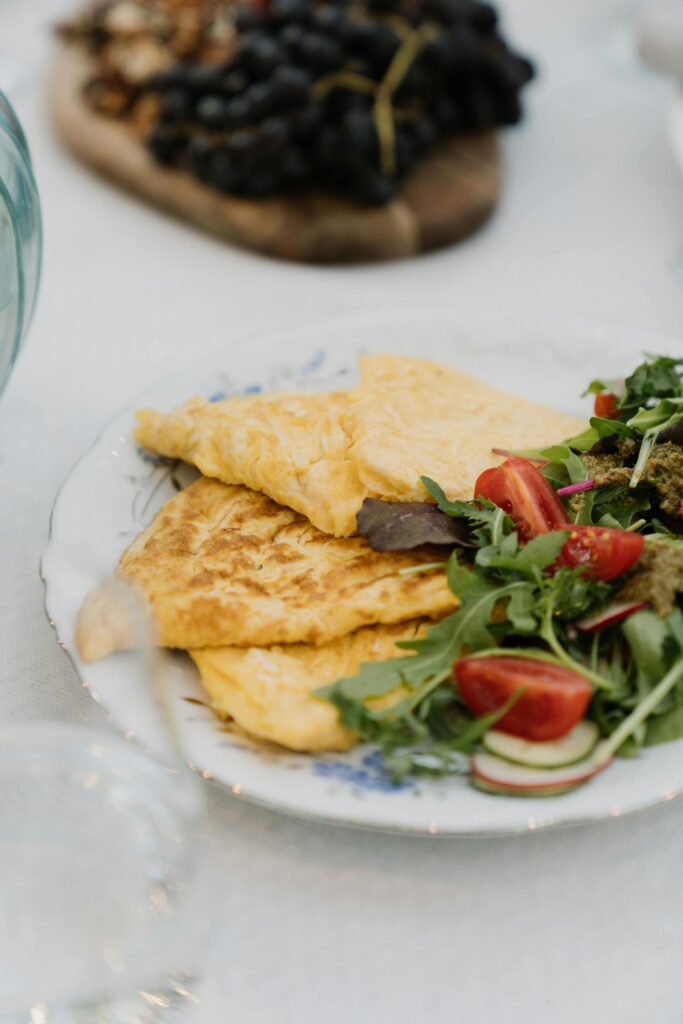
Affordable and quick prepare
Serving: 1
INGREDIENTS:
- 2-3 large eggs
- 2-3 tablespoons vegetable oil (for frying)
- 1 tablespoon fish sauce
- 1 tablespoon soy sauce (optional)
- Freshly ground black pepper
- Thai jasmine rice (for serving, optional)
Optional additions (customize to taste):
- Chopped green onions, Tomatoes
- Chopped cilantro and chilies
How To Make:
- Prepare The Eggs: Crack the eggs into a mixing bowl. Add fish sauce, soy sauce(if using), and a pinch of freshly ground black pepper. Whisk the mixture until well combined and frothy.
- Heat The Oil: Heat 2-3 tablespoons of vegetable oil in a non-stick frying pan (skillet) over medium-high heat. The amount of oil should be enough to cover the bottom of the pan generously.
- Cooking The Omelette: Once the oil is hot (not smoking), pour the beaten egg mixture into the pan. It should sizzle immediately. Tilt the pan to spread the egg mixture evenly across the surface.
- Let the omelet cook undisturbed for about 2-3 minutes or until the edges start to turn golden brown and crispy and the middle is set but still slightly runny.
- Flip The Omelette (Optionally): If you prefer, when the egg is set enough to flip, you can flip the omelet either by tossing or with a big pancake turner, and cook the other side for a few more seconds just to set. Some prefer to leave it unflipped for a more traditional Thai style.
- Garnish and Serve: Once cooked to your liking, transfer the omelet to a serving plate lined with paper towels to absorb excess oil. Lastly, Garnish with chopped green onions, cilantro, tomatoes, or fresh chilies according to your taste. Serve hot with jasmine rice and perhaps a side of sriracha or chili sauce.
Tips:
- Oil Temperature: Ensure the oil is hot enough before pouring in the eggs to achieve a crispy texture.
- Customization: Feel free to customize your Thai omelet with additional ingredients like chopped vegetables or even minced meat.
- Serve Immediately: Thai Omelettes are best enjoyed immediately after cooking to preserve their texture.
Enjoy your homemade Thai Omelette. It’s a versatile dish that can be served for breakfast, lunch, or dinner, and pairs wonderfully with rice or as part of a larger Thai meal.
7. Fried Thai Basil with Minced Pork and Rice
Fried Thai basil with minced pork, known as “Pad Krapow Moo Sap”, is a classic Thai dish loved for its robust flavors and simplicity. This dish is super affordable to make, and the ingredients are easy to find. It features stir-fried minced pork seasoned with garlic, spicy Thai chilis, oyster sauce, soy sauce, and a touch of fish sauce for depth. Once you give this a try it will be part of your weekly weeknight dinner.
The dish is brought together with fresh Thai holy basil leaves, adding peppery and aromatic notes. Served hot over jasmine rice it offers a perfect balance of savory, spicy, and herbal flavors. Make sure to prepare a massive bowl of rice because this dish is a rice killer don’t say I didn’t warn you!
Pad Krapow Moo Sap is a popular choice for a quick and satisfying meal in Thailand, reflecting the country’s culinary tradition of bold and vibrant flavors. Here’s a step-by-step recipe to make this dish a delicious dish.
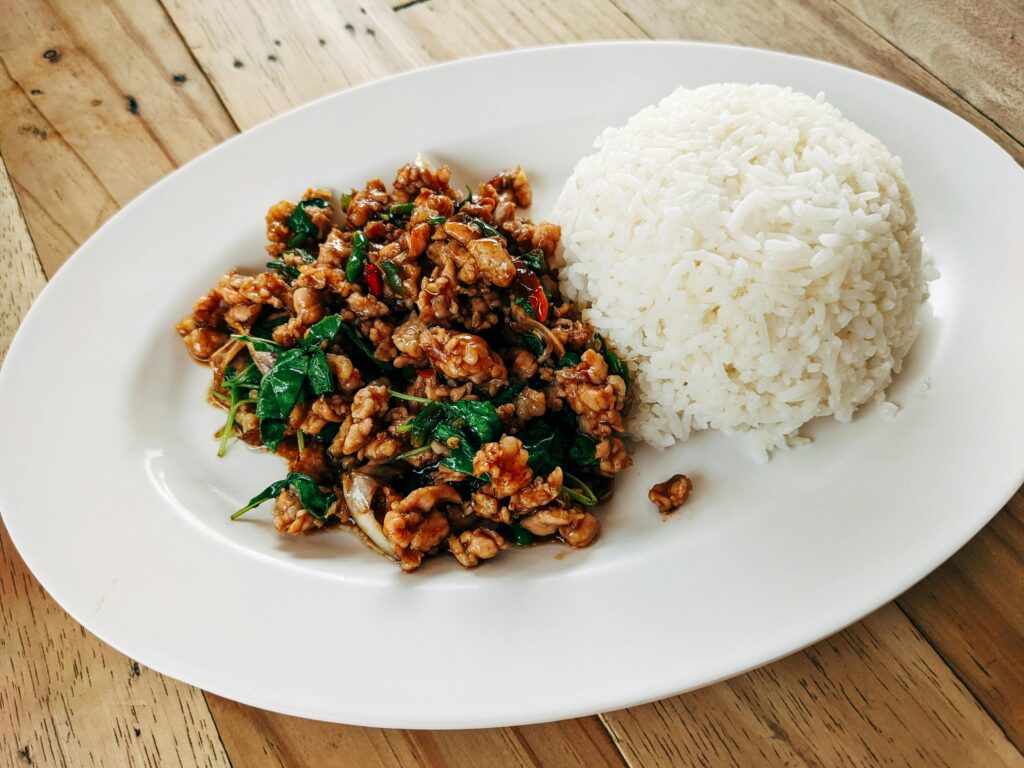
Quick and Easy meal
Robust flavors
What You’ll Need:
- 200g minced pork
- 2-3 cloves garlic, minced
- 2-3 chopped Thai chilies (adjust to taste)
- 1 tablespoon vegetable oil
- 1 tablespoon oyster sauce
- One teaspoon of fish sauce
- 1 teaspoon sugar
- 1 cup fresh Thai holy basil leaves
- Jasmine rice (for serving)
Optional ingredients (for garnish):
- Fried egg (kai dao)
- Sliced cucumber
- Sliced tomatoes
Steps for Making Pad Krapow:
- Prepare Ingredients: Heat a wok or large frying pan over medium-high heat. While heating prepare the garlic, chilies, and basil leaves.
- Cook Minced Pork: Add vegetable oil to the hot wok. Add minced garlic and chopped Thai chili. Stir-fry for about 30 seconds until fragrant.
- Now, add the minced pork to the wok. Break up any clumps and stir-fry until the pork is almost cooked through and starting to brown.
- Seasoning: Add oyster sauce, soy sauce, fish sauce, and sugar to the pork. Stir well to combine and continue cooking until the pork is fully cooked and caramelized, about 2-3 minutes.
- Add Basil Leaves: Next, add fresh Thai holy basil leaves to the wok. Stir-fry quickly for about 30 seconds until the basil leaves are wilted and aromatic.
- Serve and Enjoy: Finally, remove from heat. Taste and adjust seasoning if needed. Serve hot over jasmine rice.
TIPS:
- Basil Leaves: Thai holy basil is essential for an authentic flavor, but if unavailable, regular basil can be used as a substitute.
- Spice Level: Adjust the number of Thai chilies according to your preference for spiciness.
- Serve Immediately: Pad Krapow Moo Sap is best enjoyed hot and freshly cooked.
- Serve Immediately: Pad Krapow Moo Sap is best enjoyed hot and freshly cooked.
This Thai basil with fried minced pork and rice dish is a quick and satisfying meal that captures the essence of Thai cuisine with its bold flavors and simple preparation.
-
Apple Juice Recipe: How To Make At Home? એપલ જ્યુસ રેસીપી
Apple Juice is one of the most popular fruit beverages around the world. Its refreshing taste and numerous health benefits make it a staple in
-
Orange Juice: The Ultimate Guide to Make
Orange Juice is one of the most popular beverages worldwide, enjoyed for its refreshing taste and numerous health benefits. This bright, tangy drink is made
-
How To Make Healthy Fried Rice At Home
Healthy Fried Rice Recipe that is both nutritious and delicious. It’s perfect for a quick meal and can be customized with your favorite vegetables and
